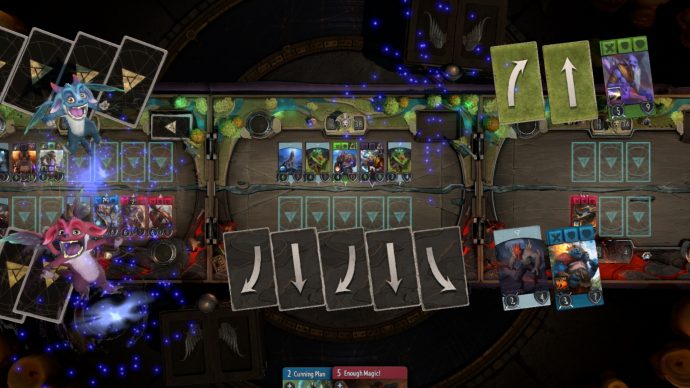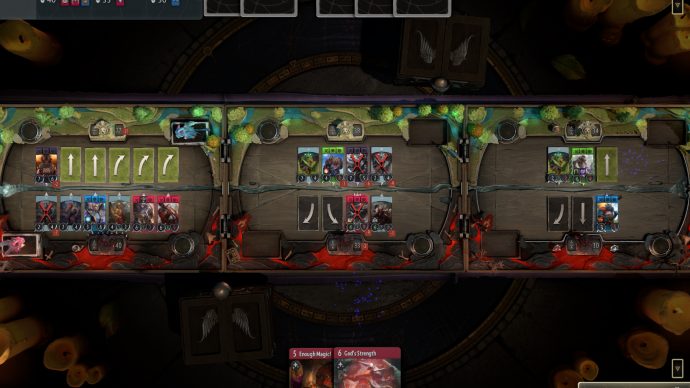
Artifact has such an enormous lattice of guidelines and mechanics permeating its CCG/MOBA chimeran mass, it takes a good period of time earlier than your thoughts turns to a few of the subtler phenomena current inside every match, and also you begin to marvel: “Wait… So how does that work again?”
Prime amongst these complicated minor-but-actually-major mechanics is Artifact Pathing, which is the game’s time period for what a unit targets every flip. As it seems, a full understanding of this deceptively easy algorithm can contribute enormously to your potential to keep away from these unlucky oh-I-didn’t-realise-that-would-happen occurrences.
Artifact Pathing information
Below you’ll discover nearly all the things it is advisable to find out about Artifact’s Pathing guidelines, together with what determines unit Pathing, the best way to reset Pathing, and the way sure skills comparable to Swap have an effect on Pathing in fascinating and presumably sudden methods. Ready? Nor am I. Apply some downward momentum to your mousewheel and let’s puzzle this out collectively.
Artifact Pathing guidelines
You could have observed throughout your games that items is not going to all the time assault what’s instantly in entrance of them, even when it looks like they need to. The reply lies with a secret set of playing cards often called Pathing Cards – and in reality, you’ve probably seen these playing cards being performed many occasions earlier than. They’re the arrow playing cards which seem briefly on the finish of the Deployment Phase, simply after you’ve purchased your gadgets and designated lanes on your heroes (should you’d like a greater grasp of the assorted phases of a game of Artifact, head on over to the Turn Structure part of our Artifact guide).
On spherical one, items will all the time path straight ahead, which makes every of the lanes at first good and simple to grasp. However, on subsequent rounds, every unblocked unit (items which aren’t instantly reverse an enemy unit) on the finish of the Deployment Phase shall be randomly assigned one among three Pathing playing cards: Forward, Left, or Right. If a unit paths ahead, then they are going to assault what’s instantly in entrance of them – i.e. the opponent’s tower. If a unit paths left or proper, they are going to assault the left or proper enemy neighbour, respectively.
Now that we’ve peeled again this precursory layer of the Pathing Onion, the necessary factor to keep in mind is that the game is biased in the direction of direct assaults. Forward Pathing has a 50% probability of occurring, whereas Left and Right Pathing every have a 25% probability. If you want you may consider it as a deck of 4 playing cards containing two Forwards, one Left, and one Right.
What’s extra, if a unit attracts a Left or Right Pathing card and there’s no corresponding enemy neighbour to focus on, then that unit will default again to a direct head-on assault. Which is sensible, actually, as a result of if not then that unit’s assault could be wasted hitting skinny air. So if two out of the three of a unit’s attainable targets are empty, then there may be truly a 75% probability that the unit will path straight forwards.

The above screenshot has been annotated to point out the general possibilities of the Pathing Cards which were assigned. Note that the top-left card is handled as a ahead arrow, as a result of there may be nothing to focus on to the left.
Artifact Reset Pathing & normal ideas
Those are the elemental tenets of the Artifact Pathing system, however there are a number of situational addenda (aren’t there all the time?) which let you assert some management over the randomness. You’ll want to recollect this stuff if you wish to keep away from getting caught abruptly throughout a match:
- Ways to reset Pathing – If a unit is pathing left or proper and one thing occurs which removes its goal from play, then that unit’s Pathing will reset to straight ahead. Similarly, should you block a unit, then that unit will reset its Pathing to a direct assault on the brand new menace. These are very helpful instruments for manipulating the genetic make-up of a lane to your benefit earlier than the Combat Phase.
- Abilities which override Pathing – There are sure playing cards which override a unit’s present pathing path and allows you to select the path it assaults. You’ll need to search for items with the important thing phrase: “Choose a combat target for X”. These playing cards, whereas situational, can present your deck with some a lot wanted utility throughout occasions when the randomness of the Pathing system doesn’t favour you.
- Unblocked areas – At any time throughout a game (not simply through the Deployment Phase), if a unit is deployed or moved to an unblocked house, a brand new Pathing Card shall be drawn to find out which path the unit will now assault.
- Blocked areas – If you deploy a unit right into a blocked house reverse an enemy unit, then it is not going to draw a Pathing Card; as an alternative it is going to path straight ahead routinely.
If you’re having bother conceptualising all this, give it some thought this manner: if there’s an area on the board for a Pathing Card to be flipped over reverse your unit, then there shall be a Pathing Card. If not, then there shall be no Pathing Card, and the unit will default to attacking straight ahead.
However! There is one notable exception to this rule, and that’s…
The Swap potential
As you’ll know should you’ve forged your eye over our helpful information on Artifact keywords, Swap is a capability which, predictably, swaps the positions of two items. Sometimes Swap is restricted to neighbouring playing cards; typically it bestows the liberty to swap with some other allied unit. However, the essential level is that this: you may swap the items round, however the pathing instructions will keep fastened in place.

It’s relatively complicated to elucidate in textual content, so I’ve ready a bit of gif under as an example this level. Here, I play Cunning Plan, which swaps the 2 items within the lower-right nook of the lane. Keep an eye fixed on their arrows, and also you’ll see that whereas at first the arrows appear to swap over together with the playing cards, they then rotate again to their authentic positions.
Artifact Pathing checks
Confused? So was I at first. Don’t fear. It takes a while to wrap your head across the intricacies of the Pathing system as a complete, however as soon as you’re taking all of those tidbits of knowledge under consideration, you’ll discover that you’ll be able to affect the game on a better variety of ranges than earlier than, and presumably than your opponent.
A good way to get used to the Pathing system and to see all these guidelines in motion is to slap collectively a take a look at deck (I’d advocate Green/Blue for the needs of this), and fill the deck with nothing however creeps and skills which transfer round or swap items. Then play towards a bot, and simply check out various things. You’ll quickly get the dangle of it, and the principles will change into second nature.
Hopefully that clarifies a number of issues, and solutions a few of the pained “but why…?” questions you had after that final game. While we’re speaking about decks, why don’t you head on over to Dave’s Artifact best decks information? Or alternatively, you could possibly have a gander at crafting your individual utilizing this helpful walkthrough of Artifact deck construction rules and pointers.




